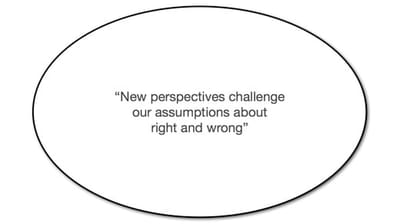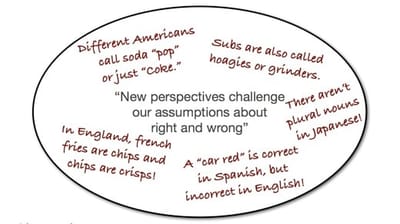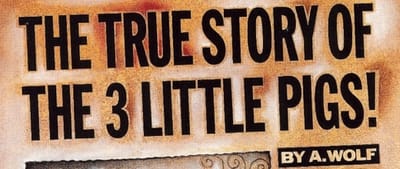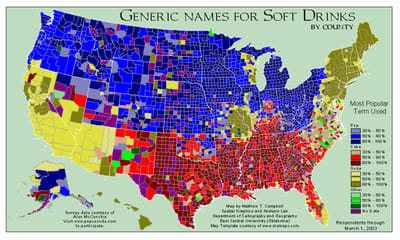It’s essential that our students think flexibly and consider multiple perspectives. Flexible thinking leads to innovation, creativity, and diplomacy. In school, however, students settle into a rigid, “one right answer” mindset.
The 👓 Multiple Perspectives prompt is one of my favorite tools of Depth and Complexity. By exploring content from multiple perspectives, our students will become comfortable with complex situations that have multiple right answers. This familiarity will help them to welcome others’ viewpoints and opinions and, hopefully, increase empathy.
Let’s dig into the topic of multiple perspectives with something familiar: common words in the English language.
This lesson assumes you’re in the US and your students speak English.
Deductive Lesson

This multiple perspectives introduction is structured as a deductive lesson, meaning we’ll begin with a “big idea” and then prove it with examples. Learn more about deductive lessons here.
Big ideas you might start with:
- “New points of view stretch our minds”
- “New perspectives challenge assumptions about right and wrong”
Tell students you’ll be looking at examples that prove this generalization. Begin a brainstorming chart with your big idea in the center and update it throughout the lesson.
Internal Differences
Let’s start by examining the various names for soft drinks across the United States. Begin by asking students what they call Pepsi, Dr. Pepper, Sprite, and so on. The answer is probably “soda” or “pop.”
Explore their thinking. Ask them what they think about calling it the other name. It will probably seem strange and wrong to them.
Now show this map and discuss the patterns of responses across the country. The country seems divided into thirds between soda, pop, and Coke.
Explore the implications: one item has three different names and each name is correct (depending on your perspective). Yet, at the same time, many think each name is also wrong. Can something be right and wrong at the same time? These terms become fuzzy as we integrate multiple perspectives. Students’ minds should be stretching.
If food is more your topic, you could continue with this guide to sandwich names in America. Are hoagies, heroes, grinders, po’ boys, and submarines all the same sandwich?
Going International

Photo by swaksalot
Let’s step outside of America and examine the conflicts that exist within English, depending on a British or American perspective.
For instance, What does “chips” mean?
| American English | British English |
|---|---|
| french fries | chips |
| chips | crisps |
We have two different foods that have the same name in the same language!
Discuss connections to the big idea. Again, both perspectives are correct. A chip is a crunchy slice of potato and it’s a long, soft fried potato. It just depends on where you happen to be.
Let students share out examples they might have about this idea.
If you’re interested, Wikipedia has many more examples of differences between British and American English.
Multilingual

Brainstorming Continues
Let’s expand one more level and look at multiple perspectives using completely different languages.
We know that learning multiple languages is a great exercise for the brain, but we don’t need to get kids fluent to take advantage of the workout. Simple structural differences across languages can stretch our minds.
For example, where does an adjective go when it describes a noun?
- In English, adjectives come before nouns: red car
- In Spanish, it’s the opposite: carro rojo or “car red”
This stretches our minds since what’s clearly wrong in one language is completely correct in another. Our thinking must be flexible in order to consider both points of view. Just as students might find “car red” funny, a young Spanish speaker would get a kick out of how silly rojo carro sounds.
Expanding further, how do we make a noun plural?
- In English, add an -s (mother becomes mothers)
- In Italian, modified the final vowel (madre becomes madri)
- In Japanese, there are no plurals! (one mother, two mother)
To an English speaker, plural nouns seem essential, yet Japanese functions perfectly well without them.
Kids might share out some cool language-related examples they know. Use these to build on their growing understanding of the big idea.
Integrate Technology
Discussing these topics is great, but what if you could get an actual Englishman to speak to your class about chips and crisps?

Skype makes this simpler than ever. Teachers can connect with other classrooms, learn from experts, and experience multiple perspectives over the internet. Skype even has an education page to help you make connections and here’s a Google Doc of teachers who Skype. Fire Skype up and find some classrooms with different perspectives.
Not ready for multimedia? Try Twitter. Krissy Venosdale and her class tweeted with a teacher in Greece and discovered that a “jumper” is a sweater. They also asked for responses about the time and weather and got answers from around the world. Nothing like pondering time zones to promote flexible thinking, right?
Homework
Finally, we’ll connect the big idea to students and their families. Point out that we even have different names for ourselves which depend on others’ perspectives:
- Students call me “Mr. Byrd”
- Friends call me “Ian” or “Byrd”
- My wife calls me “honey”
- My sister calls me “bubba”
- My mom turned that into “bubby boo”
I have several different names, but some are only “right” in certain contexts. There’s only one person in the world who can get away with “bubby boo”!
Have students talk with their family members at home about the different names they all go by. How do these names depend on multiple points of view? What are the consequences of using the wrong name in the wrong context? Discuss in class tomorrow.
What’s the point?
An opening lesson like this won’t immediately address your curriculum. Instead, it equips your class to handle advanced analysis in your content later. You can refer to the big idea of this lesson throughout the year, capitalizing on the investment you’ve made.
And keep updating that chart as kids think of new examples!
Next Steps

Follow up by reading stories rich in multiple perspectives such as The True Story of the Three Little Pigs and
The Blind Men and an Elephant.
And, of course, have students rewrite classic stories using new perspectives that stretch and challenge the original view of the story.

